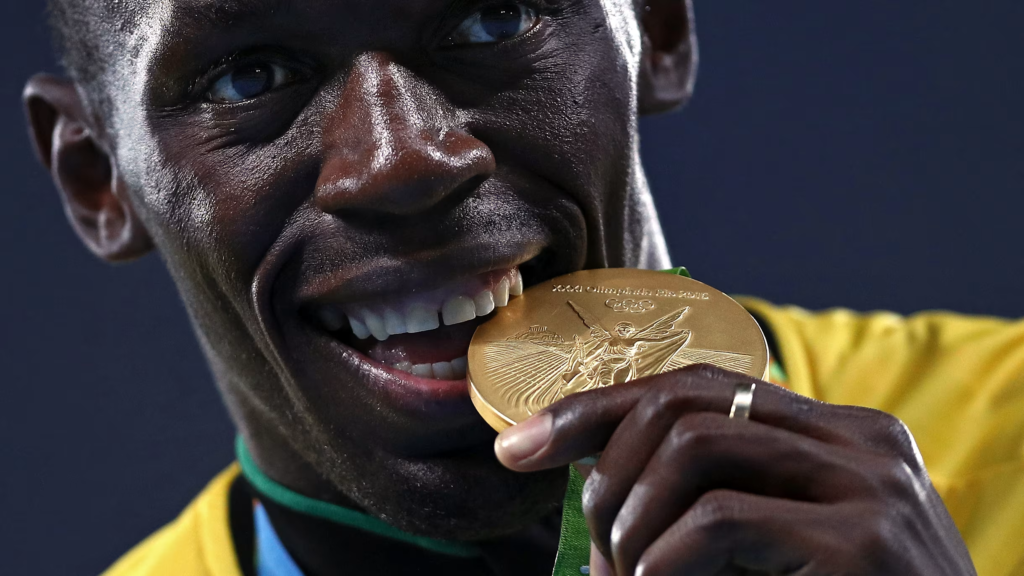One of the most captivating moments of the Olympic Games occurs when athletes stand atop the podium, celebrating their victory. Among the iconic poses and photos taken during medal ceremonies, the image of an Olympian biting their medal stands out. This gesture, seen across sports and cultures, has become an enduring tradition in the world of competitive athletics. But why do Olympians bite their medals? Is the act rooted in historical practices, simply a playful pose for photographers, or does it carry deeper meaning? The answer is a blend of history, symbolism, and modern trends. In this article, we explore the origins, evolution, and impact of this fascinating tradition.
Historical Origins: Gold Purity Testing and Metal Currency
The practice of biting precious metals dates back centuries, grounded in a time when gold and silver coins were used as currency. People would bite these coins to test their authenticity and determine their value. Gold, being a soft metal, dents easily under pressure, leaving bite marks when genuine. If a coin resisted denting, it indicated that the gold was either mixed with harder alloys or counterfeit.
This historical habit of “biting to verify” gold has no practical relevance to Olympic medals. The International Olympic Committee stopped awarding pure gold medals after the Stockholm Games. Modern medals consist primarily of sterling silver and are coated with a thin layer of gold. Nevertheless, the tradition of biting Olympic medals persists, albeit for symbolic rather than practical reasons.
Modern Influence: The Role of Photographers

The widespread popularity of the medal-biting gesture owes much to the influence of photographers. Over time, medal-biting has become a staple pose, often requested by photographers to create memorable and playful shots. By incorporating this gesture into medal ceremonies and press photos, photographers have transformed it into an enduring image synonymous with victory.
Olympians, many of whom recognize the significance of the moment, often oblige these requests, creating visuals that capture their personalities and the joy of their achievement. Some athletes see it as a lighthearted and unique way to commemorate their triumphs. However, not all medal-biting moments go smoothly. German luger David Moeller famously broke a tooth while biting his silver medal at the Winter Games—a humorous yet cautionary tale that reminds us of the risks involved.
The Symbolism Behind Medal Biting
For athletes, biting the medal is often less about following historical traditions and more about celebrating their accomplishment. The gesture has evolved into a symbol of victory and perseverance, representing the culmination of years of hard work, dedication, and sacrifice. It’s a celebratory moment that gives athletes the chance to showcase their individuality and connect with their fans.
Whether accompanied by a cheeky grin or a dramatic pose, biting the medal often serves as an expression of pride and joy. Athletes use this playful act to add a touch of personality to their celebration, making it a meaningful part of their Olympic experience. The tradition has become so engrained that many fans now anticipate the pose as part of the ceremony.
The Composition of Modern Olympic Medals

While understanding the meaning behind medal biting, it’s worth exploring the physical composition of these medals. Today’s gold medals, while striking in appearance, are not pure gold. They consist primarily of sterling silver, coated with a thin layer of gold—containing about six grams of gold on average. Silver medals are crafted entirely from sterling silver, while bronze medals are composed of copper and zinc alloys.
Given their composition, biting Olympic medals serves no functional purpose in terms of testing their authenticity. Unlike the gold coins of centuries past, these medals are not designed to be tested through physical force. Instead, the act of biting has evolved into a symbolic gesture that signifies celebration rather than verification.
The Risks and Mishaps of Medal Biting
Despite its lighthearted nature, medal biting does come with its risks. Olympic medals are meticulously crafted and hold significant sentimental and monetary value. Pressing them between teeth—especially with excessive force—can cause damage to the medal’s surface. Athletes who bite down too hard run the risk of chipping or breaking their teeth.
Though mishaps like David Moeller’s broken tooth are rare, they highlight the potential pitfalls of this tradition. Many athletes are unaware of the possible consequences until it’s too late, yet the appeal of an iconic photo often outweighs such concerns.
Cultural Significance Beyond the Olympics

The act of biting medals has transcended the Olympic Games, becoming a broader cultural phenomenon associated with victory and achievement. Athletes in various sports and competitions now mimic the pose, further embedding it into the culture of sports celebration. It’s not uncommon to see this playful gesture used in everything from amateur tournaments to professional leagues.
For fans, the image of an athlete biting their medal serves as a representation of triumph and perseverance. It captures the universal emotions tied to achieving greatness and inspires others to celebrate their own milestones with similar enthusiasm.
Why It Matters Today: More Than Just a Photo Op
While some might view the tradition of medal biting as just another fleeting trend, its symbolism goes deeper. For athletes, this gesture is a tangible expression of pride, resilience, and the fulfillment of lifelong dreams. It also provides an opportunity for athletes to connect with their audiences in a personal way, sharing moments of genuine joy in ways that transcend language and cultural barriers.
Moreover, the tradition embodies the Olympic spirit, reflecting the unity, hard work, and passion that define the Games. Through this act, athletes contribute to the collective imagery of the Olympics—one that transcends individual events to become part of the broader story of human achievement.
Conclusion: A Timeless Tradition Rooted in Celebration
The tradition of Olympians biting their medals is a captivating blend of historical practices, modern trends, and personal expressions. While its origins lie in the testing of gold for authenticity, it has evolved into a playful and symbolic gesture that celebrates the pinnacle of athletic achievement. For photographers, fans, and athletes alike, the act of biting the medal captures the joy, pride, and individuality of Olympic success.
Whether it’s motivated by tradition, prompted by photographers, or simply a spontaneous moment of celebration, medal biting remains an integral part of the Olympic experience. It connects past and present, honoring the timeless pursuit of excellence and the joy of triumph.
Also Read: Can Cats Eat Bananas? Understanding the Feline Diet






